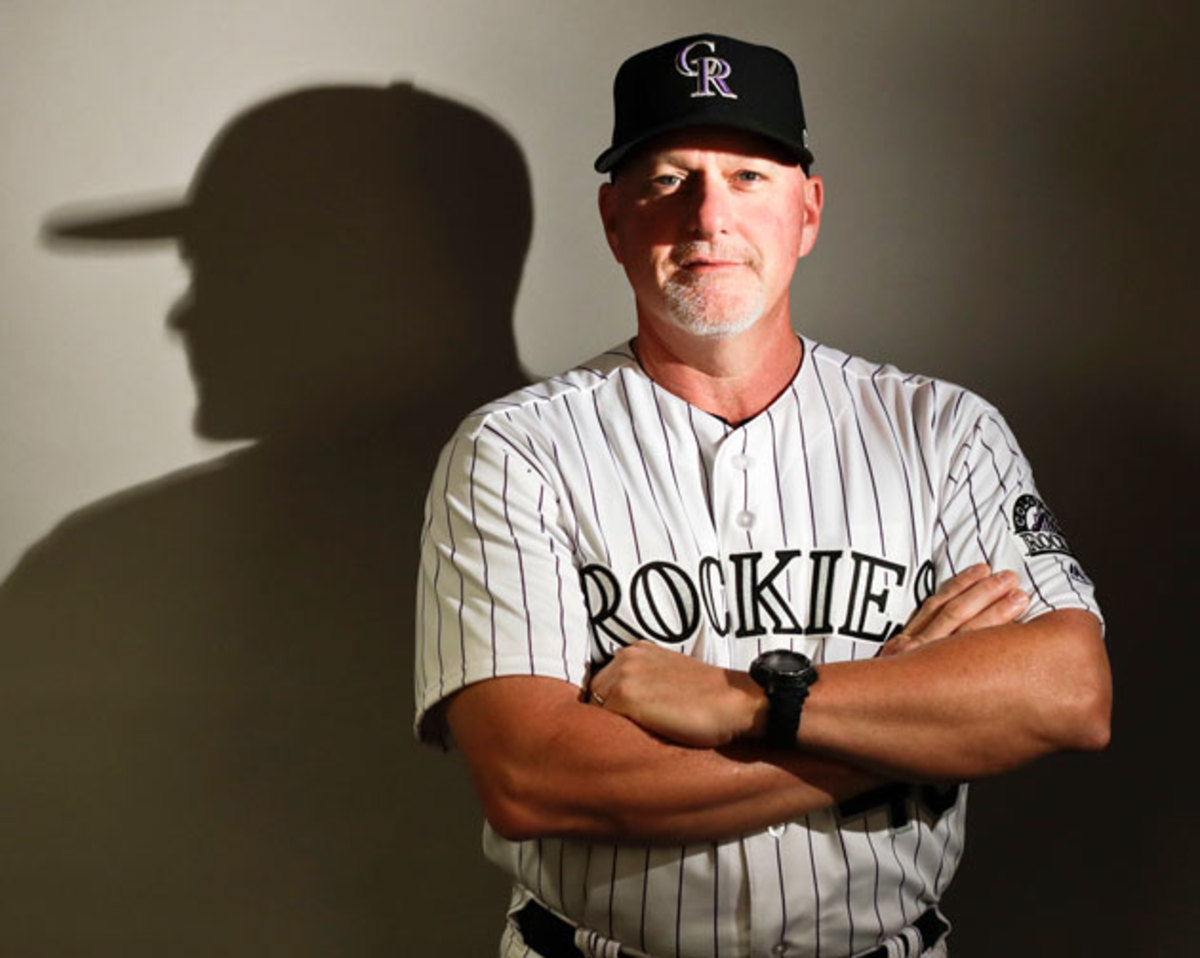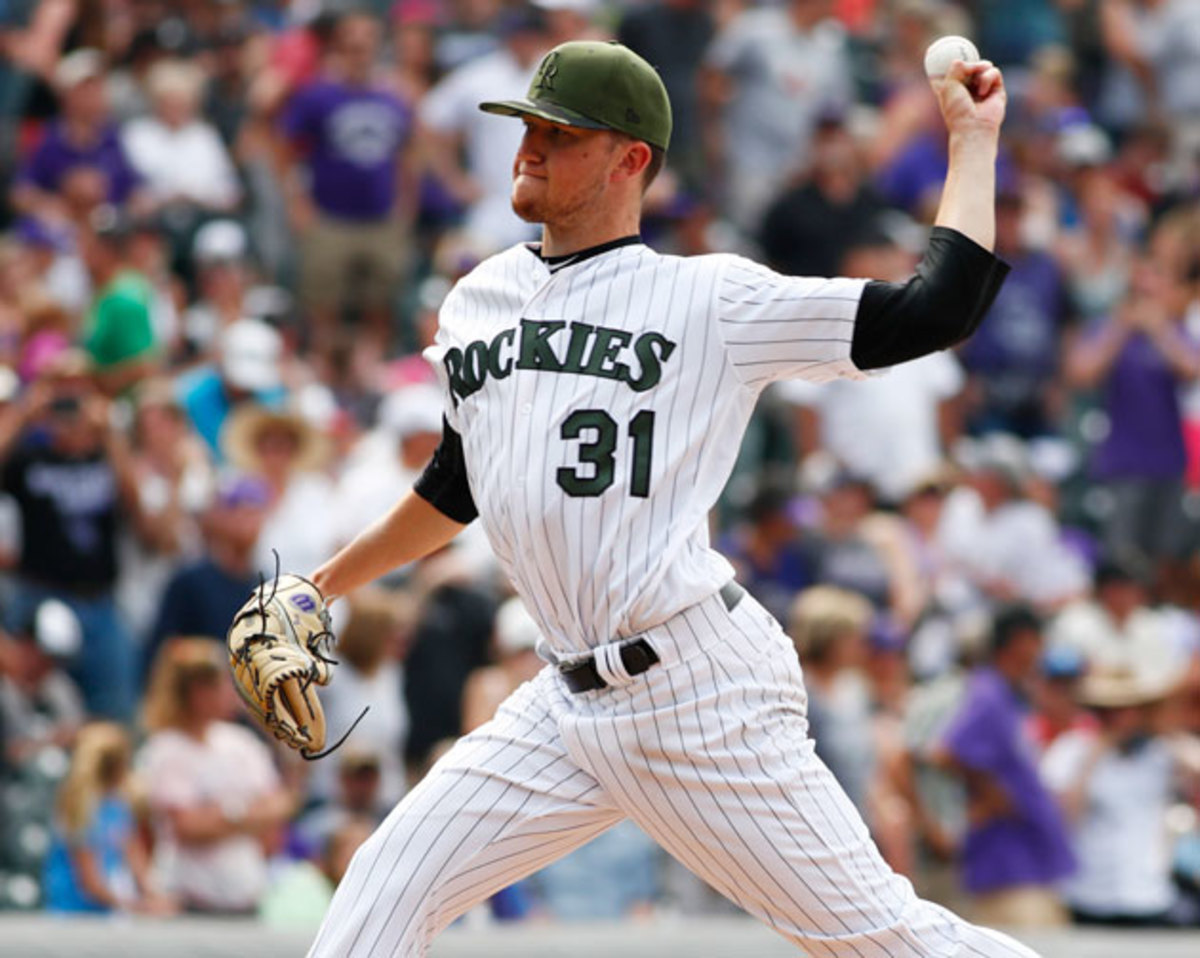The Colorado Rockies and Coors Field: A tale of struggles, homers and acceptance

This story appears in the July 17, 2017, issue of SPORTS ILLUSTRATED. To subscribe, click here.
Before we get to the top-secret projects, or the ghost stories that will make your hair stand on end, or the key to cracking the most baffling puzzle in baseball, let’s begin with the first pitcher chewed up and spit out by the beast.
It was 1993, the first year of major league baseball in Colorado. In front of 67,000 fans at Mile High Stadium, freshly minted Rockies closer Darren Holmes dashed from the bullpen to the mound, unaware that he was heading straight into the teeth of the monster. “I thought I was Lee Smith,” recalls Holmes, then a brash, goateed 27-year-old righthander whom the Rockies regarded so highly that they had taken him with the fifth overall pick in the expansion draft five months earlier.
In his Denver debut Holmes gave up three straight singles, a double and a walk before recording his first out. He threw 24 pitches and allowed seven runs in a 19–9 loss. He took the mound again in the following game, and with the chance to close out a 4–2 win, Holmes—suddenly unable to locate his curveball, his signature pitch—walked the first three hitters he faced, allowed three runs to score, blew the save and took the loss.
The previous season, in Milwaukee, he had been one of the best relievers in the game. It took two weeks in Colorado for him to be banished to the minors, his confidence in pieces.
The list of pitchers who have been crushed by the beast is long—they range from the prominent to the obscure, from high-priced free agents to waiver-wire pickups, from that first Colorado team to members of the 2016 staff, which was among the majors’ worst. Holmes and his 1993 teammates could not pinpoint the reasons for their diminished powers in their home park, but they did begin to notice strange things in the thin air: breaking balls that didn’t break and baseballs that jumped off the bat “like golf balls on the moon,” as Tony Gywnn would put it. “The second season, people started talking about the effects of altitude,” says Holmes. “Then we moved to Coors Field [in 1995], and the mystique of pitching in altitude got bigger and bigger, and the beast has gotten so big now that it’s all people think about.”
Holmes rejoined the big league team later in 1993, and he ended up pitching for the Rockies for five often successful seasons before leaving as a free agent. Three years ago, while enjoying a quiet life in retirement as an independent pitching coach in North Carolina, he got an unexpected phone call. It was the Rockies, coming off a 96-loss season and still trying to solve the puzzle of high-altitude baseball, asking Holmes to return as a coach. “To come back to the scene of the crime,” he says.
As he spoke, Holmes, now in his third season as a bullpen coach, was sitting in the coach’s locker room in Philadelphia one afternoon in late May. Colorado was the surprise of baseball: the leader in the NL West with a young pitching staff that was then on pace to post the lowest ERA in franchise history, in a season in which home run rates across the majors were at a record high. (The team has cooled off since then but still has a 7.5-game wild-card lead with a nearly league-average 4.45 ERA through Sunday.) The start was beginning to prompt questions about whether the Rockies, after all these years, might have finally figured out how to slay the beast.
To those questions, Holmes only laughs. The man knows better. He will tell you: No one will ever kill the beast.
*****

This is the 25th season of the Rockies franchise, and there is still something refreshingly singular about baseball in the shadow of the Rocky Mountains: the electric purple uniforms that make traditionalists’ stomachs turn; the breathtaking vistas—a life-sized Bierstadt painting just beyond the outfield—and hail storms that seem to have blown in from north of The Wall in Westeros; a brand of homer-happy baseball that seems controlled by 12-year-olds with joysticks. After years of analysis—physicists across the country have made a second living off Coors Field–related study—there are no more mysteries about why baseball in Colorado is the way it is. It’s no secret that because games are being played at 5,200 feet, where the air density is about 80% of what it is at sea level, air resistance is 20% less, baseballs carry 20% farther and breaking pitches move 20% less. (If you have your doubts, “The Coefficient of Restitution of Baseballs as a Function of Relative Humidity” is available online.) It’s also no secret that pitchers are at a further disadvantage because reduced oxygen levels at altitude tax the body and make recovery after each game and workout more difficult than at sea level.
And it’s no secret that pitching at Coors Field is the toughest and, perhaps, the least desired job in baseball. Any longtime Rockies player will tell you so. They remember what Mike Hampton, still the highest-paid free-agent pitcher in franchise history, said after he left in 2002 with a 6.15 ERA just two seasons into a eight-year, $121 million deal: “I was going to prove it could be done or die trying. I almost died trying.” They remember what venerated pitching coach Dave Duncan said while with the Cardinals: “I don’t think there’s any circumstance I would feel comfortable as a coach in this ballpark. It would challenge me beyond my ability to accept the challenge.” Holmes, who played with the Braves after leaving Colorado, recalls the Atlanta teams of the early 2000s adjusting their all-world rotation so that their best pitchers at the time would be skipped in Colorado. “It was, Which one of the three is going to win the Cy Young?” he says. “Because whoever’s got the best statistics, we’ll hold them out.”
Still, one can find evidence—sporadic, not sustained—of pitchers enjoying success in Colorado. When Dodgers starter Hideo Nomo tossed a no-hitter in 1996 at Coors, the event was hailed like a moon landing. “I’m betting it won’t be done again,” L.A. first baseman Eric Karros said at the time, and 21 years later he’s still waiting. The Rockies, with a better-than-league-average staff, went to the World Series in 2007, and the team made the postseason again in 2009. But they haven’t returned since.
Year after year, while Colorado’s offense consistently ranks among the league’s best, the pitching conundrum remains at the root of the losing. (In all but eight years of the team’s existence, the staff has ranked dead last in the NL in ERA.) To solve the riddle, the Rockies have gone to extreme measures, from the installation of a ball-storing humidor in 2002 to the implementation of a four-man rotation in 2012 to last season’s raising of fences. Five years ago the Rockies held their starters to a 75-pitch limit, with three ‘piggyback’ relievers eating the middle innings. The plan was initiated by then general manager Dan O’Dowd and referred to within the executive offices as Project 5183, in honor of Coors Field’s base elevation. When it was unveiled to the public, it was bold, it was revolutionary—and it was a massive failure: The staff again finished last in ERA as the team lost a franchise-worst 98 games. “You start to think of every freaking thing to not get your ass handed to you year after year,” says one longtime official. “And I mean every freaking thing.”
Cubs comeback? Texas-sized milestone? Home run history? Second-half stories to watch
The Rockies have conducted studies into weather patterns, into heat and humidity on game days. (The Rockies are the only team in baseball with their own weather station at the ballpark.) They have hired a slew of consultants. For every idea that has been put in place, dozens have been discussed but either scrapped or set aside. Years ago officials considered turning the ballpark into a dome and pressurizing it to mitigate the effects of the thin air. More recently the front office and training staff discussed converting the entire home clubhouse at Coors Field into a hyperbaric chamber to help players recover in an environment where there’s a lack of oxygen.
“Every little thing has been studied. One approach was, ‘We’re going to run all the time to be more in shape than the other guys,” says reliever Adam Ottavino, who, in his sixth season, is the longest-tenured pitcher on staff. “But the only thing that happened was that everyone was just tired all the time.”
While the humidor did restore some sanity (scoring dropped by nearly 20% in its first year, before going up again in recent seasons), Coors continues to be by far the most inflated offensive environment in the sport. Since 2001 runs per game are about 33% higher there than the league average.
The franchise that’s undergone more reboots than Spider-Man has hit the reset button again this spring with the hiring of former Padres manager Bud Black, the team’s fourth skipper in nine years. The current organizational shift actually began in 2012, with O’Dowd stepping down as GM to focus on revamping the minor league system and longtime pitching coach Mark Wiley coming on as pitching coordinator. Senior director of player development Jeff Bridich was promoted to GM in 2014 and quickly began stockpiling elite young pitching through the draft: Riley Pint and Robert Tyler (2016), Mike Nikorak (2015), Kyle Freeland (2014) and Jon Gray (2013) were all first-round selections.

Beginning last year, despite the club’s posting a 4.92 ERA, there were signs that the investment in development was beginning to pay off: Gray went 10–10 with a 4.61 ERA in his first full season; according to Fangraphs WAR—which adjusts for ballpark—it was the best rookie season in baseball. And this season Colorado has fielded an all-homegrown rotation that is the youngest in the majors, featuring Gray (age 25), Freeland (24), Tyler Anderson (27), Tyler Chatwood (27), German Márquez (22) and Antonio Senzatela (22), who replaced Gray in the rotation after the ace went down with a foot injury in April. It’s a mix of power pitchers (Gray, Márquez), ground ball specialists (Chatwood, Freeland) and command artists (Anderson, Senzatela).
“For a long time there was a belief that sinker-slider was what worked best,” says Steve Foster, who in 2015 took over as Rockies pitching coach, working closely alongside Holmes. “Well, the problem is that sinkers don’t sink as much [at Coors], so you’re essentially going after pitchers who you want to move the ball more to get more ground balls, but it moves less, so you’re handcuffing those guys bringing them here.”
Says front office assistant Bob Apodaca, who was the team’s major league pitching coach for 10 years, “You can look back at the evidence over the years and see that there are no absolutes that might simplify how to win there. Aaron Cook. Pedro Astacio. Jeff Francis. Ubaldo Jiménez. Jorge de la Rosa. Those were my most successful guys—and they were different in the way they succeeded.”
The relievers Bridich acquired over the last two years are all hard throwers with high spin rates on their off-speed stuff: closer Greg Holland and Mike Dunn, signed this off-season, and Jake McGee and Chad Qualls, added a year ago, joined a bullpen that included Ottavino, a power pitcher who has been one of the better relievers in the league over the last six seasons despite pitching at Coors. “Our theory is that we’re looking for guys that have the least amount of contact—power arm, high strikeout guys with high spin rates on their breaking ball,” says Foster.
Colorado’s hurlers take the mound armed with information from the Rockies’ expanded analytics group and also from a staff of veteran coaches, from Apodaca to Holmes, who would be qualified to write a user’s guide to pitching in Coors—one that might begin like this:
Tip No. 1:Change your “sights.” Because breaking balls don’t break as much at home as they do on the road, pitchers should change their aim depending on where they’re pitching. “You typically pick out spots on the catcher, whether it’s his left or right knee, but you make that small adjustment up or down depending on if you’re home or away,” says Freeland. “If you have a big breaking ball and want to get a lot of depth on it, in Colorado you’re going to have to start that pitch a little lower for it to end in the location you want.”
Tip No. 2: Dump your side sessions. The body is taxed more at Coors than at sea level, so to save energy some Rockies cut their side sessions and workouts when they’re on a home stand.
Tip No. 3: Chew gum. “The air is so dry that no matter how much water I drink, I feel like I’m peeing it all out and I’m hungover without drinking any alcohol,” says Ottavino. Dry air results in dry fingers, which changes a pitcher’s grip. Chewing gum allows a pitcher to retain more saliva; pitchers are permitted to lick their fingers on the mound.
Of course, the tricks of the trade can only take a pitcher so far. “Most importantly, you have to be a tough son of a bitch to pitch well in Denver. Mental toughness is the thread that runs through the guys who succeed here,” says Apodaca. Tough—or maybe even a little crazy. Last winter, when Dunn, a longtime Marlin, was on the market and expressed an interest in pitching for Colorado, the sentiment surprised even those inside the Coors Field offices. “The reaction was, Wow, he’s f------ nuts!” says one Rockies official. “That’s the kind of guy we want!”
*****

Jon Gray believes in ghosts. He was 10 years old when, in bed in his home in Oklahoma, he looked up and saw a woman walking across the room. Terrified, he crawled into bed with his parents, who at first dismissed his vision but later, after other strange occurrences, believed him enough to have the house blessed and, ultimately, to move out. Gray doesn’t blame anyone for rolling their eyes—“I’d be doing that myself if someone told me about a ghost walking across the room”—but that experience has shaped the way he looks at the world. “Anything unexplained or mysterious has always been very interesting to me,” he says. “I want to know why strange things happen the way they do.”
Gray brought up the story one day at his locker to make a point about facing fears. He’s faced his by embracing them, turning ghost hunting into a hobby: He took his fiancée and dad for two nights to the Colorado hotel that inspired The Shining and had MLB Network follow him on one of his expeditions to Milwaukee’s notoriously spooky Pfister Hotel. When he was drafted by the Rockies No. 3 overall out of Oklahoma, there were plenty of reasons to be scared. “My first year I was at Grand Junction [with the rookie league team, 240 miles from Denver], and I got winded really fast,” he says. “That was a moment when I was like, O.K., pitching here is going to be different. But so what? I liked the challenge.”
To some, the young ace of the Rockies, who gave the team a jolt when he rejoined the rotation in late June and won his first two games back, is Colorado’s great hope—IF JON GRAY CAN’T DO IT FOR THE COLORADO ROCKIES, SHUT IT DOWN, read the headline in the Colorado Springs Gazette on the day of Gray’s 2015 debut. Gray, who last season was actually better at home (4.30 ERA) than on the road (4.91), has the arsenal to succeed anywhere, with a fastball that reaches the high 90s and one of the majors’ most effective sliders. He also represents a room full of pitchers who are undaunted by the Rockies’ haunted past. These players accept that they’ll see strange things in their time as Rockies, that giving up four or even five runs over five innings is more often than not a successful start here.
“Something we talk about is that for every team, there’s something,” says Holmes. “Seattle flies 20,000 miles for a road trip every time. Atlanta plays in dense humidity. If you want to be a Rockie, well, you just have to face different parameters.”
Of course in Colorado more than anywhere else, it’s about how you finish. “I’m the only guy left from the time I came in here, six years ago—every other guy has come and gone,” says Ottavino. “A lot of them are really good pitchers and have gone other places and done well. But half the guys I was with were just defeated by Coors Field. It just got to them eventually. By the end of it you saw them beaten by this place. They got off the plane, and they just didn’t want to show up to face it anymore. Things are going well now, but the true test is going to be what these guys are feeling coming off the plane come August and September.”
After 25 years of baseball in Colorado, a quarter century of madcap experiments and broken souls, this much is clear: There is no magic bullet for conquering the high altitude. If there’s a solution to the greatest puzzle in baseball, the Rockies now understand, it’s simply being better—better at drafting players, better at developing them; better at finding cheap, undervalued pitchers; better at staying strong and healthy, to withstand the inevitable challenges that come with playing in the most unpredictable environment in baseball.
“People think I’m crazy, but I’ve always loved Coors Field,” says Holmes. “There’s nothing like it. It is a great place for baseball. And it is, despite what everyone thinks, a place that can be pitched in.” Holmes thinks back to all the pitchers and coaches who have been shattered by the place. How they all looked for ways to outsmart it, to beat it, to kill it. But it took him more than two decades to understand that they had it all wrong.
You cannot slay the beast. The only thing to do is to learn to live with it.
